 Author: Eiji OKUBO Sales Network: Amazon.com / Amazon.co.jp |
| Written by Eiji Okubo, Printed books and e-books Heritage of Minoan and Mycenaean civilizations Detailed data on Ruins and Excavated items |
| The World of Crafts and Arts of the Mycenaean Civilization "Pottery" |
 |
| subtitle: Data and explanations of excavated items language: English format: Paperback printing paper: Non-glossy high-quality paper printing ink: High-saturation premium ink size: 8in.x10in. (203mm x 254mm) 263pages sales: Amazon Network / Amazon.com / Amazon.co.uk |
| Sumary: This book is 8in. x 10in. (203mm x 254mm) version, 260 pages, a "Precision Illustrations & Data Book" of excavated items from the prehistoric Mycenaean Civilization ruins in the mainland Greece. This book is picked up 190 items of outstanding Mycenaean Pottery excavated from important ruins of the Mycenaean Civilization in the Argolis, Messenia, and Laconia regions, including the Mycenae Palace and surroundings ruins, which were the center of the Mycenaean Civilization. More than 90% of the excavated items explained are depicted in Precise Illustrations, and the rest are shown in Photographs. This book will invite you to the "World of Crafts and Arts" of the Mycenaean Civilization through carefully selected important works from among the excavated items on display at the National Archaeological Museum of Athens and other archaeological museums throughout the Peloponnese. Contents: I What is the Mycenaean Civilization? II Pottery from Neolithic Age to Middle Helladic MH period III Pottery of Late Helladic LHI period IV Pottery of Late Helladic LHII period V Pottery of Late Helladic LHIIIA period VI Pottery of Late Helladic LHIIIB period VII Pottery of Late Helladic LHIIIC period |
| Sample Page:(excerpt) ---------- III-09 Spherical Jug 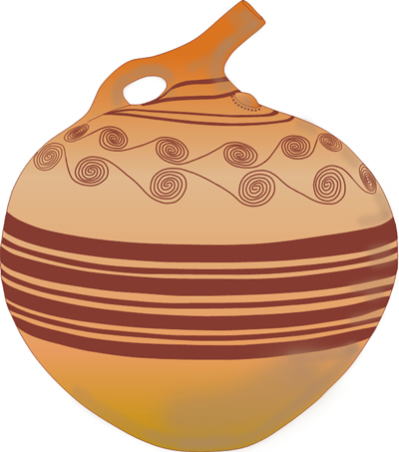 Site: Shaft Grave II, GCA, Mycenae Palace Shape & Decoration: Spherical Jug, horizontal line pattern and chained spiral Era: MHIII, 1625-1550 BC Museum: NAM, inv. No. 200 / H295mm Local: Argolis, Peloponnese Drawing: Eiji OKUBO Related: Grave Circle A (GCA), Mycenae Palace In 1876, German businessman J.H. Schliemann discovered a double stone slab circle with a maximum outer diameter of 27.5 m inside the citadel of the Mycenae Palace ruins in the Peloponnese-Argolis region, currently a UNESCO World Heritage Site. The circular ruins were a large cemetery called "Grave Circle A," which dates back to the 16th century BC. Grave Circle A in the Mycenae Palace is located immediately to the right of the interior after entering through the Lion Gate, the main gate of the palace area. In Grave Circle A, the Shaft Grave I to Grave V were discovered during Schliemann's excavation work, and later the Shaft Grave VI was discovered by Greek researcher Panagiotis Stamatakis. Schliemann called initially this area of Grave Circle A the "Agora" which later meant a public square and market place in Ancient Greece. 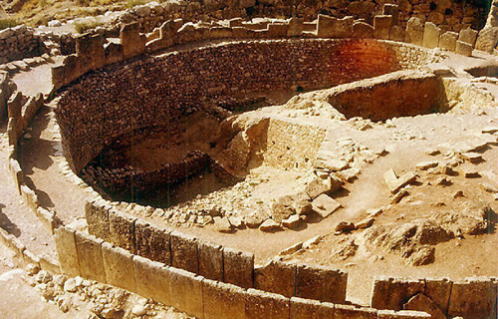 Site: Grave Circle A, Mycenae Palace Situation: A unique Mycenaean cemetery a) double slab circle=outer diameter 27.5m, inner 25m b) center left tomb=largest Shaft Grave IV c) center right tomb=Shaft Grave I Era: MHIII-LHI, 1625-1500 BC Local: Argolis, Peloponnese / 11km north-northeast from Argos city Photo: 1982 GPS: 37°43'49.50''N 22°45'23''E / ALT 240m 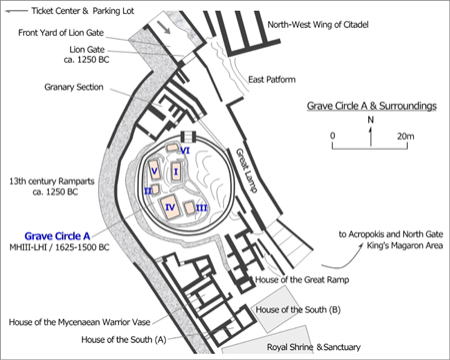 Site: Plan of Grave Circle A & surroundings, Mycenae Palace Local: Argolis, Peloponnese Drawing: Eiji OKUBO Grave Circle A had a structure in which double circle-shaped stone slabs surrounded the ground surface. The stone slab circle is not a perfect circle, but a slightly distorted, almost circular shape, with the maximum outer diameter of the outer circle being approximately 27.5m, and the inner diameter of the inner circle being about 25m. A total of 19 bodies had been buried in Grave Circle A, including eight adult men, nine women, and two children. The burial persons are undoubtedly members of the second or third generation of the royal family who lived in the Mycenae Palace approximately 3,600 to 3,500 years ago, or members of the royal family or relatives, such as the king's brothers. Burial bodies in GCA: Shaft Grave I: 3 women Shaft Grave II: 1 man Shaft Grave III: 3 women and 2 children Shaft Grave IV: 3 men and 2 women Shaft Grave V: 3 men Shaft Grave VI: 1 man and 1 woman VI-01 Pictorial style, Stemmed-Krater In the Pictorial style of the krater vessels, the luxury goods produced at the Tiryns Palace largely reflected the tastes of the export destinations. They include: bulls with large dotted bodies, small heads, larger eyes, slender legs, and men with crushed round noses. In some cases, a combination of bulls and waterfowl was depicted. The pattern motifs of general-purpose pottery include: new symmetrical compositions, the panel type decoration that creates wide spaces by dividing the body of the vase with three vertical grooves, and vertically painted whorl-shells in krater type vessels and kylix cups. These all patterns became very popular. In addition, deep bowls with rosette pattern on the shoulder, stirrup jars with handles with floral designs such as papyrus and lilies, were also developed. All of them are characterized by their extremely sophisticated vessel shapes and designs. 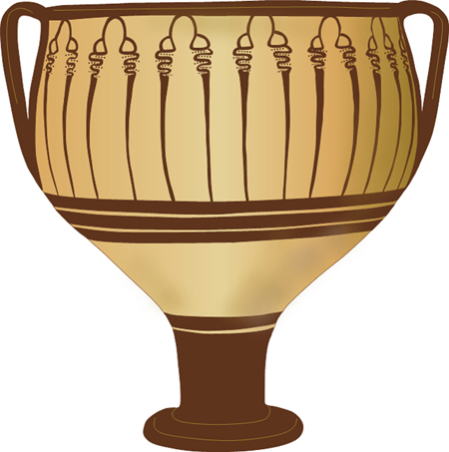 Site: Citadel, Mycenae Palace Shape & Decoration: Pictorial style, Krater with leg, whorl-shell pattern Era: LHIIIB1, 1300-1250 BC Museum: NAM, inv. No. 1148 / H370mm Local: Argolis, Peloponnese Drawing: Eiji OKUBO VI-02 Pictorial style, Krater vessel 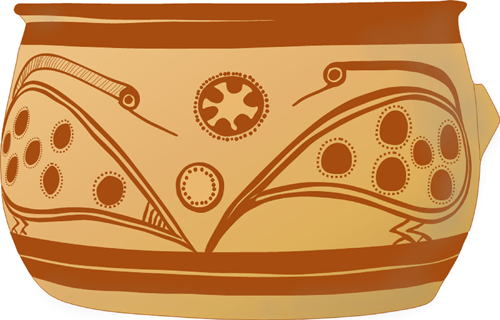 Site: Citadel, Mycenae Palace Shape & Decoration: Pictorial style, Krater large waterfowl, rosette, circle & stippling patterns Era: LHIIIB, 1300-1200 BC Museum: NAM, inv. No. 1275 / H170mm Local: Argolis, Peloponnese Drawing: Eiji OKUBO Related: Acropolis – Throne Room Megaron Complex 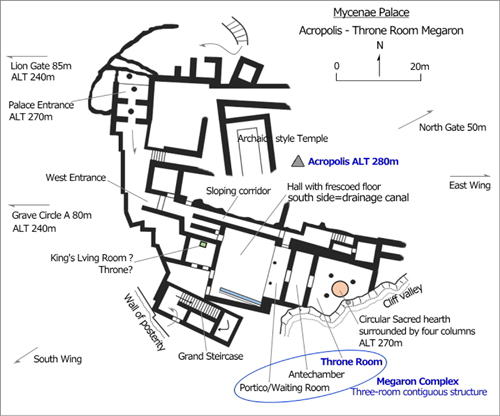 Site: Plan of Citadel, Mycenae Palace Situation: Acropolis – Throne Room “Megaron Complex” Era: built=MHIII, ca 1600 BC or slightly later collapse=LHIIIB2, ca 1200 BC or slightly later Local: Argolis, Peloponnese Drawing: Eiji OKUBO Related: Megaron Complex, Mycenae Palace 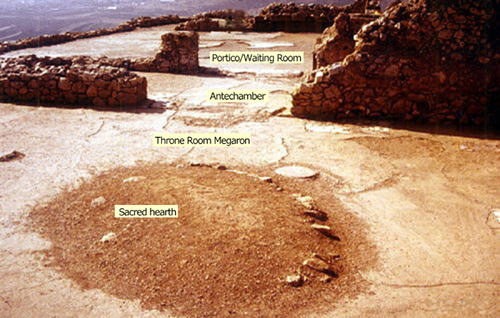 Site: Throne Room and surroundings, Mycenae Palace Situation: Megaron Complex=Three-room contiguous structure a) distant=Portico/Waiting Room b) middle=Antechamber c) front=Throne Room with Sacred hearth surrounded by four columns Era: built=MHIII, ca 1600 BC or slightly later collapse=LHIIIB2, ca 1200 BC or slightly later Local: Argolis, Peloponnese Photo: 1982  Site: Argos Area, Tiryns Palace? Shape & Decoration: Pictorial style, Krater, whorl-shell pattern Era: LHIIIB, 1300-1200 BC Museum: NFAM, inv. No. 5528 / H200mm Local: Argolis, Peloponnese Drawing: Eiji OKUBO IV-03 Palace style, Amphora type Jar 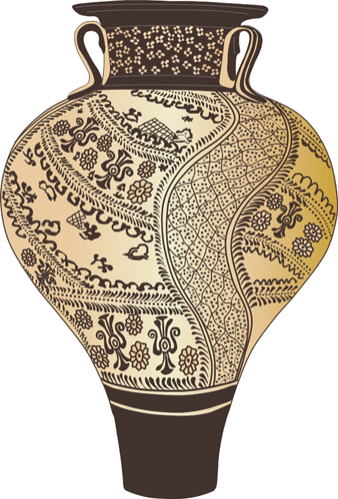 Site: Royal Tholos Tomb, Vaphio Shape & Decoration: Palace style, Amphora type Jar “Sacral Knots,” rosette, comma, reef and seaweed patterns Era: LHIIA, 1500-1450 BC Museum: NAM / H100cm Local: Laconia, Peloponnese Drawing: Eiji OKUBO Related: Royal Tholos Tomb, Vaphio 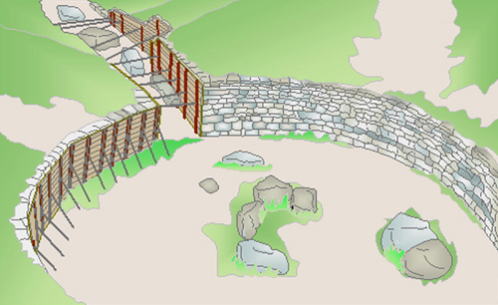 Site: Royal Tholos Tomb, Vaphio (as of 1982) Situation: Mycenaean Tholos Tomb inner diameter 10m, remaining wall height 1.6m Era: LHIIA, 1500-1450 BC Local: Laconia, Peloponnese / 7km south-southeast from Sparti city Drawing: Eiji OKUBO GPS: 37°01'13''N 22°28'04''E / ALT 195m IV-05 Palace style, Amphora type Jar, Floral design 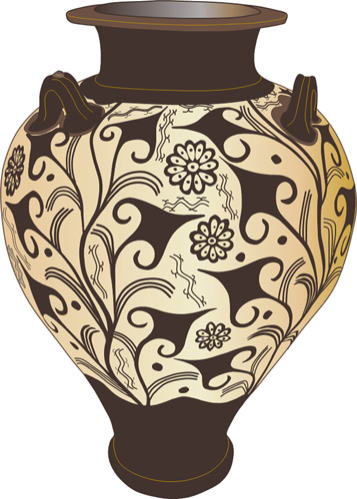 Site: Circular Tomb, Nestor’s Palace Shape & Decoration: Palace style, Amphora type Jar ivy leaf, rosette patterns in floral design Era: LHI-LHII, 1550-1400 BC Museum: CHAM, inv. No. 1586 / H703mm Local: Messenia, Peloponnese Drawing: Eiji OKUBO IV-11 Spherical Beaked Jug, Marine design 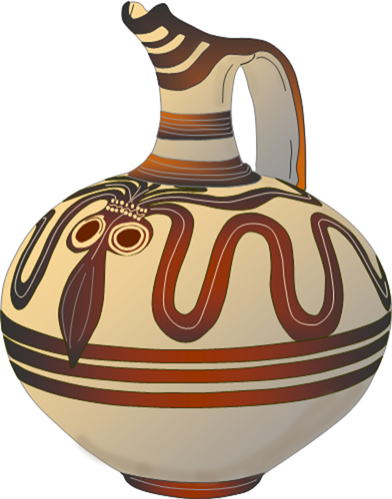 Site: Chamber Tomb 14, Heraion (old name Prosymna) Shape & Decoration: Spherical Beaked Jug Marine design=octopus and thick lines patterns Era: LHII, 1500-1400 BC Museum: NFAM, inv. No. 5505 / H240mm Local: Argolis, Peloponnese Drawing: Eiji OKUBO Related: Tangles type Dagger, Dolphin pattern from Chamber Tomb 14 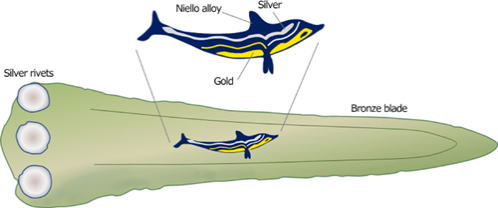 Site: Chamber Tomb 14, Heraion (old name Prosymna) Shape & Decoration: Bronze Dagger of the “Tangles type” a) inlaid decoration of gold, silver, niello alloy, dolphin on each side of the blade b) silver rivets on the shoulder part Era: LHII, 1500-1400 BC Museum: NAM, inv. No. 8446 dagger length L186mm / dolphin length L38mm Local: Argolis, Peloponnese Drawing: Eiji OKUBO VI-18 Kylix 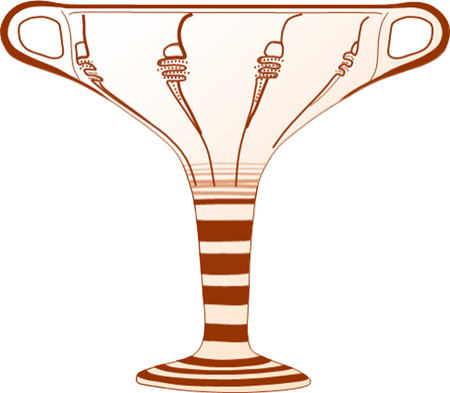 Site: Chamber Tomb, Markopoulo Shape & Decoration: Kylix, whorl-shell pattern Era: LHIIIB, 1300-1200 BC Museum: NAM, inv. No. 3740 Local: Attica / 6km south from New Athens International Airport Drawing: Eiji OKUBO VII-04 Pictorial style, Krater 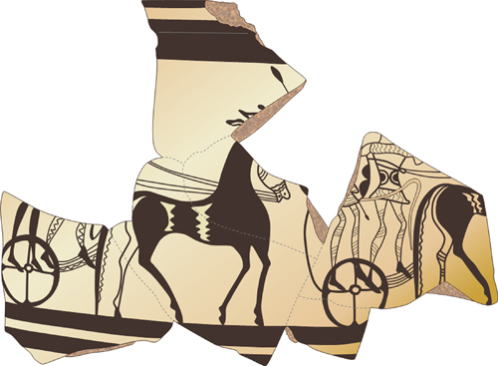 Site: Lower Town, Citadel, Tiryns Palace Shape & Decoration: Pictorial style, Krater, two-wheeled chariots and Mycenaean soldiers Era: LHIIIC, 1200-1150 BC Museum: NFAM, inv. No. 14336 / L410mm Local: Argolis, Peloponnese Drawing: Eiji OKUBO VII-10 Granary style, Stirrup Jar 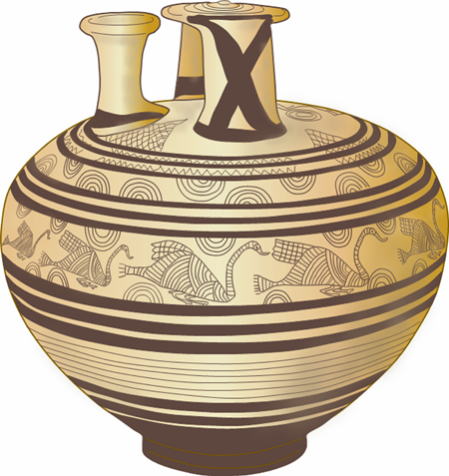 Site: Granary section, Citadel, Mycenae Palace Shape & Decoration: Granary style, Stirrup Jar with handles Close style: patterns of waterfowl, semicircles, horizontal stripes Era: LHIIIC, 1200-1150 BC Museum: NFAM, inv. No. 2844 / H220mm Local: Argolis, Peloponnese Drawing: Eiji OKUBO ---------- |